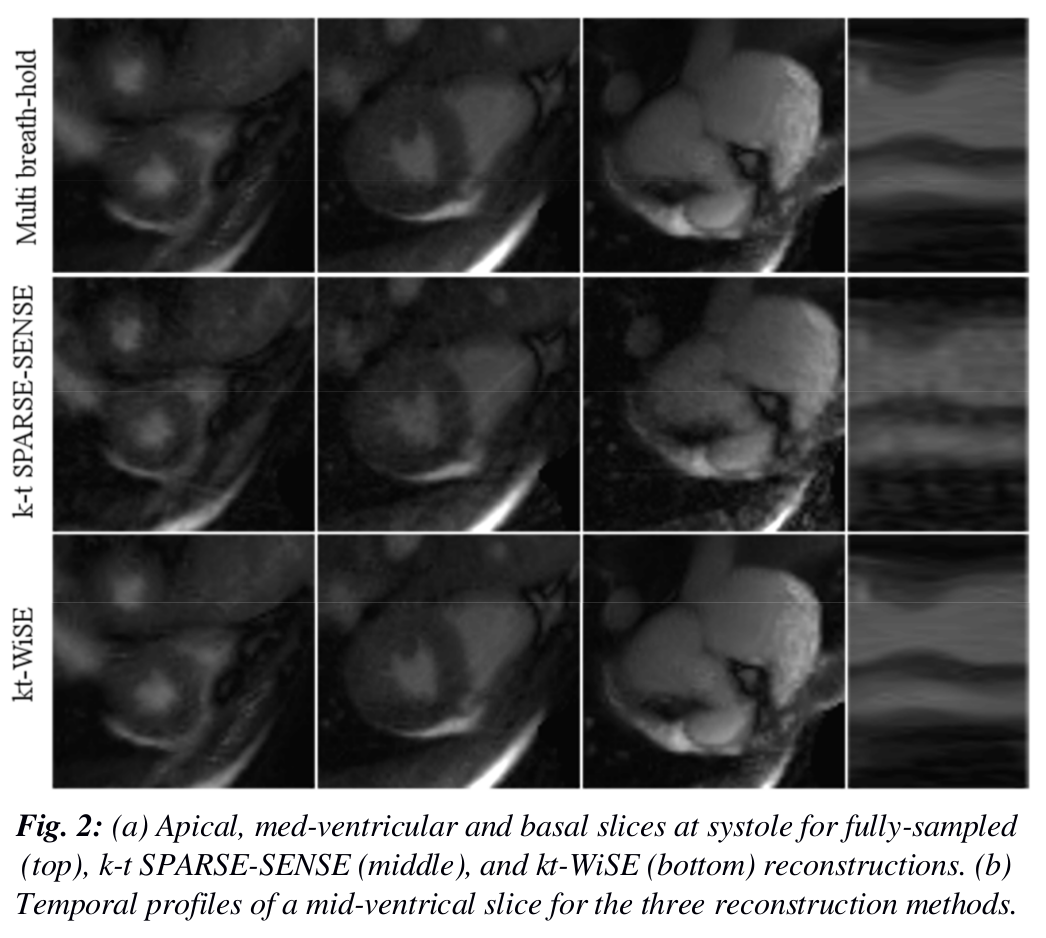New MRI reconstruction method presented at ISMRM 2015

A new recontruction method for Single Breath Hold, Whole Heart Cardiac Cine MRI have been accepted for presentation at the 23rd Annual Meeting of the International Society of Magnetic Resonance in Medicine: "Single Breath Hold Whole Heart Cine MRI With Iterative Groupwise Cardiac Motion Compensation and Sparse Regularization (kt-WiSE)".
Purpose: Multislice 2D (M2D) CINE MRI is a clinical gold standard for the assessment of ventricular volumes and cardiac function. However, this acquisition currently needs to be performed during several breath-holds, leading to slice-misalignment and long scans duration. In this work we propose a novel undersampled reconstruction approach to perform M2D whole heart CINE MRI in a single breath hold. The proposed method, which we call kt-WiSE, is based on compressed sensing (CS) and a groupwise temporal registration algorithm for the estimation and compensation of the motion of the heart. The proposed approach was tested on healthy volunteers with data acquired on a golden radial trajectory [1], and compared against the gold standard M2D acquisition.
Theory and Methods: Compressed sensing has been shown to highly accelerate CINE MRI by exploiting sparsity of the signal in the temporal domain [2]. Motion compensation (MC) has been incorporated into the CS reconstruction to achieve sparser temporal representations by reducing interframe cardiac motion [3,4]. These MC-CS methods enable higher acceleration factors, however present remained artifacts due to motion estimation/compensation errors. To overcome these problems we propose a joint optimization approach [3] for both the image and motion parameters. This MC-CS approach uses a spatio-temporal regularized groupwise registration algorithm based on a non-rigid B-splines deformation model and can be formulated as iteratively solving a reconstration and a motion estimation problem. A healthy male volunteer was scanned with a 32-element cardiac coil and a golden radial trajectory on a 1.5T Philips scanner. 16 cardiac phases were retrospectively reconstructed (16 profiles per phase), leading to a temporal resolution of 46.4ms. A conventional fully sampled, Cartesian, multi breath-hold scan was performed with similar acquisition parameters for comparison. Total data acquisition time was 11.1 s in the proposed single breath-hold scan and 1 min 42 s in the Cartesian one (without considering resting intervals between breath holds). Sensitivity maps were estimated from a separate scan. For comparison, data was also reconstructed using k-t SPARSE-SENSE [2] with temporal Fourier transform as sparse domain.
Results: Apical, medial and basal slices at end systole where reconstructed from the multi breath-hold Cartesian data and from the single breath hold golden radial data with k-t SPARSE-SENSE and the proposed method (kt-WiSE). Sharper edges and better overall quality was obtained in the last case. Better temporal fidelity can be perceived for the kt-WiSE image.
Conclusions: Preliminary results indicate that a standard multislice protocol could be realizable in a single breath-hold, leading to a noteworthy reduction in the scanning time and potentially impact in patient comfort and medical resources allocation. In this preliminary setup, each slice is reconstructed independently. Performing the reconstruction of all the slices jointly could lead to image quality improvement, given the spatial redundancy between consecutive slices.. Further studies will be performed to validate the proposed approach and extended to 3D acquisitions.
Acknowledges: This work was partially supported by the Banco de Santander-FPI-UVa 2012 grant program.
References: [1] Winkelmann et al. IEEE TMI 2007, [2] Otazo et al. MRM 2010, [3] Prieto et al. MRM 2007, [4] Lingala et al. IEEE TMI 2014, [5] Metz et al. MedIA 2011.
